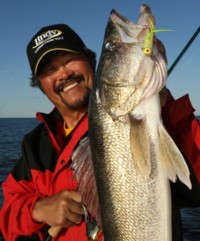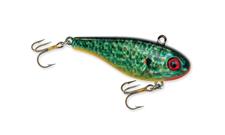Ted Takasaki Continues the Tradition
Category: article
Mar 2nd, 2010 by OutdoorsFIRST
Modified Mar 2nd, 2010 at 12:00 AM
Walleye First
Tournament Series
Ted Takasaki has come full-circle, and loves the traditions of the area he has called home for more than a decade. “I look at Brainerd, Minnesota, as a fishing mecca,” he said. He knows how the theories and innovations that originated in Brainerd influenced fishing.
 |
|
|
Lindy Pro Ted Takasaki
|
He was commenting on the article which follows, written specifically for his hometown newspaper. “The confluence of these great fishing minds in one area created ideas, tactics and tackle that worked,” he said. “Many companies and industry leaders got their start in Brainerd, and remain here: Jeff Zernov, Gary Roach, Babe Winkelman, Al and Ron Lindner, Lindy, In-Fisherman, Nature Vision and many more.”
Takasaki knew it was a great place to live and fish, and it was his dream to live amongst the giants of the industry. “My schedule keeps me on the road and I don’t get as many chances to fish the Brainerd lakes as I want,” he said. He started his “hardcore” fishing career upon graduation from college and at the same time began a very successful sales-engineering career with Hewlett-Packard which led to numerous top honors.
“My first sponsor was Lindy Little Joe, where I met Nick Adams. The relationship grew and later I served 10 years as president of this fine company,” he said. When Lindy was purchased by PRADCO, and later moved to their Arkansas headquarters, Takasaki put on a familiar cap, and is now a pro staffer again.
While in the head office, his approach was to promote and publicize with marketing to the masses and promotions aimed at teaching anglers and potential anglers “one at a time.” This effort involved a wide variety of guides and tournament anglers. “Lindy supported both, because the tournament guys got the publicity and the guides shared their boats with so many clients,” he said. Lindy also used print, radio and TV advertising to create awareness of new products. “Now, the internet is a very strong element in the promotional game,” he said.
“When the main walleye magazine ceased publication, there were not as many opportunities for tournament anglers to get into the media. Lindy reduced tournament anglers to a select handful who do substantial PR-work and promotions. They cultivated a guide field-staff with the ability to contribute and promote fishing (where, what, how of specific lakes) on website message boards.
Despite the “new” media (internet), he reminisced about the PWT Championship he won in 1998, saying, “I was using Fuzz-e-Grubs, and this was a shot in the arm for a tried and true item that had been around for a long time.” Back in December, at the St. Paul Ice Show, he said a simple tank demonstration of the new Lindy Darter boosted sales tremendously. “Ice sales are up 75 percent, and the Darter sales are way over the most optimistic projections. It catches fish,” he said.
 |
|
|
Lindy Darter, Bluegill Pattern
|
Takasaki has come full-circle, and is back in the promotional saddle as a one-on-one teacher, a pro staffer for Lindy and other marketing partners, and on the water filming and fishing tournaments. In 2010, he will fish a combination of AIM and FLW events. “I enjoy the promotions side of this business as much as I do the fishing. I like meeting the people,” he said. That and success on the competitive tours may be part of the reason he will be inducted into the National Freshwater Fishing Hall of Fame in March.
———————————————————————————————–
Brainerd Lakes: The Epicenter of Fishing Innovation
(A Story Written by Jim Kalkofen for the Brainerd
Dispatch Outdoor Traditions Section)
There’s a reason it’s called the “Brainerd-lakes” area, not just Brainerd. Water abounds. It’s our heritage. It’s also the main ingredient in the recipe called, “Fishing Innovation.” Brainerd, Minnesota, will forever be rooted in history books as one of the major centers of ideas, tackle and tactics that propelled the fishing industry forward.
Nick Adams, long-time head of Lindy Little-Joe fishing tackle said, “This area virtually became the epicenter of innovative fishing tactics.” Dr. Roland Kehr, local dentist and former board member of Lindy said, “It appears we’re a super-mecca for tackle and fishing creativity, and have been for decades.”
Joe Fellegy, one of Minnesota’s foremost chroniclers of things “fishy,” said, “We live in the hot-bed of how-to. Once Ron Lindner understood people would pay for fishing know-how, the rest of the world couldn’t catch-up.” Al Lindner viewed it like this, “Education was the heart-beat. We lived in a hot-bed of scientific fishing and shared what we learned in magazines and television.”
Adams, ever the philosopher, suggested that our forefathers, mostly from the Scandinavian countries, and the Native Americans fished here for generations, “It’s in our genes; it’s what we do,” he said. Fishing innovation evolved from the love of fishing, and includes major tackle companies like Normark, Lindy, Northland, Gopher, plus many local manufacturers and the Nisswa Guides League.
Products were being made in Brainerd, and tourists and anglers helped spread the word. “Lindy was an innovator in promotions, and the Lindy rig had the support of top guides. Our pro tam members traveled widely,” he said. Lindy started from the simple Lindy rig, credited to Al and Ron Lindner. “Ron was a genius, way ahead of his time, but he came to me saying, ‘We’re broke.’ He wanted start-up money, but I told him to get $250,000 of orders. He did. I borrowed the money, our business was started on a hand-shake, and our formula for success was as simple as the Lindy rig: Ron was the creator. I was the businessman. Al was the promoter. It was sort of a big carnival act!”
Among the four patents he holds, Adams was especially proud of the No-Snagg walking sinkers. He said the Thill Night Bright fishing floats were one of the greatest revenue producers ever. “Over the decades, we refined old-standards to produce fish. Each advancement served a purpose,” he said.
The epicenter in Brainerd grew naturally, he said, “We had the people, the water, the desire to improve old techniques and bring creative new products to market, the right conditions, a good promotional image, solid companies and a good reputation.”
Doc Kehr said the multi-species available in the diverse lakes and rivers made Brainerd a unique area. “With about 425 lakes in a 25-mile radius, the likelihood of success was much greater,” he said. “Add Al and Ron getting together with Nick, the promoters like Roach, the Lindy team and Babe and In-Fisherman coming on the scene, and the backgrounds of the many guides who branched out and chased many species made this the fishing innovation center that remains today.”
Joe Fellegy saw the revolution coming while guiding walleyes on his Mille Lacs launch. He was one of the original writers and editors for the Lindners when they began In-Fisherman. He was fond of adding the “P” to the famous In-Fisherman formula. “They originally had F + L = P. I changed it to F + L + P = Success. This will remain forever,” he said. The formula: Fish + Location + Presentation = Success. He said to have remained in the magazine business meant he could not spend seven days a week guiding. He returned to the water. “I still get nostalgic about those years,” he said.
These lessons and theories from Buck Perry and Bill Binkelman became fishing wisdom that served as the impetus for the new tackle being invented here. Then, light line, small hooks, flashers and leeches popped onto the scene, and backed with promotions for the Lindy rig, “A huge transition occurred and the growth curve raced upward,” Fellegy said.
“With a profit to be made and the right products and thinkers here in the Brainerd area, the Hucksters of How-to went to market,” he said with an affectionate chuckle. “We had the perfect combination of people in the 1970’s, and they’re still here, along with a new generation keeping the trends alive.”
Al Lindner said, “Rigging and jigging walleyes was an adventure for guides; resorts were full of tourists and vacationers flocked here. Mille Lacs, Leech, Pelican, Gull, Whitefish and hundreds of smaller lakes were loaded with fish – all species.” Then he cited the factors, listing the reasons for the confluence of fishing innovation as he saw them after returning from the Vietnam jungles in 1968:
1. The Nisswa guides League was big, with Marv Koep constantly promoting.
2. The Lindy staff in the early days, with Gary Roach, Babe Winkelman and dozens of other experts – and Ron and me — on the PR trail.
3. The waters of the area.
4. The Lindy rig and resultant promotions.
5. Tactics like back-trolling, long rods, flashers, leeches, light mono, trolling motors, fishing deeper fish, maps. spinnerbaits and worms came onto the scene.
6. The In-Fisherman magazine and television series, packed with how-to lessons.
7. A public desire to learn more about where and how to fish, and master the new methods and gear exploding onto the market.
8. Fishing Experts moving into the area and the promotional team bringing
tactics from down south and all over North America back to Brainerd.
“We promoted like crazy on TV, with outdoor writer fishing trips, filing fishing reports, writing our theories in the magazine, speaking at sport shows, and the more we did, the more that products and tactics sprang into life,” Lindner said. Also a fact, but seldom recognized, he said, “Anglers wanted to learn about a specific tactic and adapt it to the species they fished for. They could hire a guide and didn’t have to take a road-trip on their own.”
Lindner said, “Per capita, the Brainerd area has more highly skilled anglers than any other area I know of compared to the rest of the country.” Speaking of the lakes area, he said, “Within 60 miles of Brainerd, we have the best mix of multi-species fishing in the country.” Whether under the ice or in summer, he remains amazed at the diverse opportunities. “Plus, there’s so much interest in so many species,” he said. “In my opinion, it’s better today with bigger fish.”
Lindner said he catches bigger bass today than in the early years. Catch and release plays a big part in bass and muskies, and even big walleyes are being released, he said, “Smallmouth bass is better than ever; muskies are all over, and it’s easier to catch big crappies today.” He said pike is not the same quality (for big pike) as in the past, but they can still be caught. With the quality of fishing and the people living here, Lindner said, “The Brainerd area will remain a hot-bed of fishing innovation and creativity well into the future.”
Author’s Note: The Brainerd-Lakes area Chamber of Commerce describes the area on their phone message as the “Fishing Capital of Minnesota with 465 lakes.”